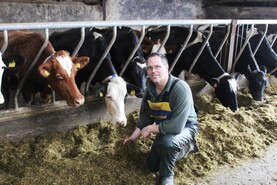The village section of the open day is an area dedicated to specific topics. Researchers present their work and interact with the crowd in small groups. The following is a sample of some of the most interesting topics discussed.Pushing stocking rate
The village section of the open day is an area dedicated to specific topics. Researchers present their work and interact with the crowd in small groups. The following is a sample of some of the most interesting topics discussed.
Pushing stocking rate
Donal Patton presented the results from the Ballyhaise study, which looked at what happens when you push stocking rate over what the farm can support. He compared net profit when milk price is at 24c/l, 29c/l and 34c/l at varying levels of feed self-sufficiency. The range, depending on stocking rate and grass growth was between 50% and 90% self-sufficient.
At 34c/l, all systems are equally profitable. As milk price drops, there is a linear drop in net profit in line with lower levels of self-sufficiency. This is because bought-in feed had to fill the hole in the feed wedge created by the extra cows. There was a loss of €800/ha in the 50% self-sufficiency treatment when milk price was at 24c/l.
The message: match stocking rates to what the farm can grow. High stocking rates are not resilient.
The perfect cow
This village attracted the most attention. There were six cows on display: three Jersey crossbreds and three high EBI black and white cows from the Next Generation Herd. Which cows are the perfect cows?
Frank Buckley said both cows are perfect cows in their own right, depending on what you want, but he said that the crossbred cows are the most profitable.
“The average farmer with black and white cows would be around €150/cow better off by crossbreeding. The Next Generation Herd is hitting all of our targets, but those cows are 10 years ahead of the national herd,” Frank said.
When asked if there would be a faster genetic gain by sticking with Holstein Friesian, he said that if the current level of genetic gain in the two breeds continues, it would be 2040 before the Holstein Friesian outperforms the Jersey crossbred.
The message: use the highest EBI sires from the top of the active bull list and use Jersey sires for extra milk solids production.
Clover
There was huge interest in the clover section also. Results from Clonakilty show a 25kg of milk solids per cow increase when cows are on grass and clover swards v grass only with an extra 1.5t/ha of grass grown too.
Every year, the researchers are learning more and more about how best to manage clover. Fergal Coughlan no longer gives bloat oil to prevent bloat. On the 5% of paddocks with over 50% clover, he grazes these at a higher cover than normal around 1,700kg rather than 1,500. This increases the fibre content of the sward and he allocates the grass in 12-hour allocations when they graze those fields. He hasn’t had a case of bloat in two years.
No silage is cut off fields with a very high clover content as this exacerbates the problem and leads to clover taking over. High clover fields lose cover over winter so he grazes this last when closing up for the winter.
Profitable systems
If you had 100 cows on 100 acres, how would you make an extra €23,000 per year? This challenge was addressed by Liam Hanrahan who works on economic modelling. The key factors when it comes to increasing profit is to focus on grass utilised and calving rate. Every extra tonne utilised is worth €173. For every 1% increase in six-week calving rate, net profit per cow, for all cows in the herd increases by €8.22.
Liam showed that if the farm grew an extra 2t/ha by improving soil fertility, reseeding and grazing management that net profit would increase by €13,840. Getting the herd out for an extra 10 days at grass would generate an extra €740. Increasing the six-week calving rate by 10% would generate an extra €8,220. Between the three, net profit would increase by €22,800.
The message: focus on what is happening inside the gate before looking outside the gate.
Read more
Grass is key in dairying fight against Brexit
Full coverage: Moorepark 2017





SHARING OPTIONS: